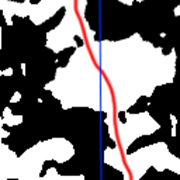Machine learning prediction of tortuosity in digital rock
DOI:
https://doi.org/10.25299/jgeet.2023.8.02-2.13875Keywords:
Tortuosity, Digital Rock, Machine Learning, Convolutional Neural NetworkAbstract
Physical rock property measurement is an important stage in energy exploration, both for hydrocarbons and geothermal sources. The value of physical rock properties can provide information about reservoir quality, and one of these properties is tortuosity. Tortuosity is an intrinsic property of porous materials that describes the level of complexity of the porous arrangement when a fluid passes through it. Conventionally, tortuosity values are measured through laboratory analysis and numerical simulation, but these measurements can take a long time. An alternative method for measuring tortuosity is using machine learning with a convolutional neural network (CNN). A CNN is a type of deep neural network designed to analyze multi-channel images and has been applied successfully to classification and non-linear regression problems. By training a CNN on a dataset of digital rock samples that have been simulated using numerical computation to obtain their tortuosity values, it is possible to demonstrate that CNNs can accurately predict the tortuosity of digital rock. The result is that the CNN model can predict tortuosity values with the Xception model being the most accurate with the lowest RMSE value of 0.90962.
Downloads
References
Al-Raoush, R.I., Madhoun, I.T., 2017. TORT3D: A MATLAB code to compute geometric tortuosity from 3D images of unconsolidated porous media. Powder Technology 320, 99–107. https://doi.org/10.1016/j.powtec.2017.06.066
Ansari, O.B., Binninger, F.-M., 2022. A deep learning approach for estimation of price determinants. International Journal of Information Management Data Insights 2, 100101. https://doi.org/10.1016/j.jjimei.2022.100101
Chollet, F., 2017. Deep learning with Python. Manning Publications, New York.
Dandekar, A.Y., Sondergeld, C.H., Rai, C.S., 2018. Machine learning for digital rock characterization: Opportunities and challenges. Geophysics 83, MR13–MR23.
Gao, Y., Mosalam, K.M., 2018. Deep transfer learning for image-based structural damage recognition. Computer-Aided Civil and Infrastructure Engineering 33, 748–768.
Graczyk, K.M., Matyka, M., 2020. Predicting porosity, permeability, and tortuosity of porous media from images by deep learning. Scientific Reports 10, 21488. https://doi.org/10.1038/s41598-020-78415-x
Howard, A.G., Zhu, M., Chen, B., Kalenichenko, D., Wang, W., Weyand, T., Andreetto, M., Adam, H., 2017. MobileNets: Efficient convolutional neural networks for mobile vision applications. https://doi.org/10.48550/arXiv.1704.04861
Huang, G., Liu, Z., van der Maaten, L., Weinberger, K.Q., 2017. Densely connected convolutional networks. Presented at the Proceedings of the IEEE Conference on Computer Vision and Pattern Recognition, IEEE, pp. 4700–4708.
Iorga, C., Neagoe, V.-E., 2019. A deep CNN approach with transfer learning for image recognition, in: 2019 11th International Conference on Electronics, Computers and Artificial Intelligence (ECAI). Presented at the 2019 11th International Conference on Electronics, Computers and Artificial Intelligence (ECAI), IEEE, Pitesti, Romania, pp. 1–6. https://doi.org/10.1109/ECAI46879.2019.9042173
Ladopoulos, E.G., 2014. Non-linear three-dimensional porous medium analysis in petroleum reservoir engineering. Universal Journal of Fluid Mechanics 2, 1–11.
Neumann, R., Andreeta, M., Lucas-Oliveira, E., 2020. 11 Sandstones: raw, filtered and segmented data [WWW Document]. URL www.digitalrocksportal.org (accessed 12.27.22).
Neumann, R.F., Barsi-Andreeta, M., Lucas-Oliveira, E., Barbalho, H., Trevizan, W.A., Bonagamba, T.J., Steiner, M.B., 2021. High accuracy capillary network representation in digital rock reveals permeability scaling functions. Scientific Reports 11, 11370. https://doi.org/10.1038/s41598-021-90090-0
Talo, M., 2019. Convolutional neural networks for multi-class histopathology image classification. arXiv:1903.10035.
Tang, P., Zhang, D., Li, H., 2022. Predicting permeability from 3D rock images based on CNN with physical information. Journal of Hydrology 606, 127473. https://doi.org/10.1016/j.jhydrol.2022.127473

Downloads
Published
Issue
Section
License
Copyright @2019. This is an open-access article distributed under the terms of the Creative Commons Attribution-ShareAlike 4.0 International License which permits unrestricted use, distribution, and reproduction in any medium. Copyrights of all materials published in JGEET are freely available without charge to users or / institution. Users are allowed to read, download, copy, distribute, search, or link to full-text articles in this journal without asking by giving appropriate credit, provide a link to the license, and indicate if changes were made. All of the remix, transform, or build upon the material must distribute the contributions under the same license as the original.










